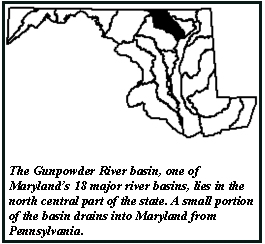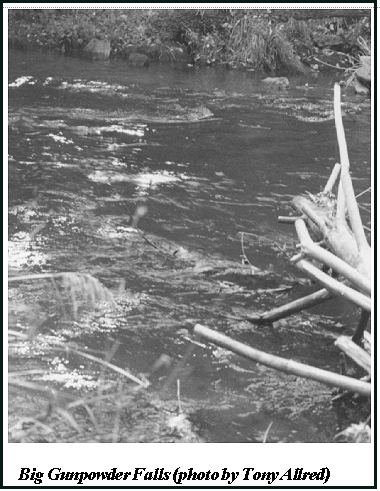This page is designed to provide scientific reports pertaining to the Gunpowder Watershed. A rich variety of resources contribute to the success of this page. Both governmental and non-governmental authors publish on a wide array of topics. We will be providing executive summaries of these reports as well as their full versions in downloadable format. For moreinformation please contact Charlie Conklin at gunpowderws@hotmail.com.
GUNPOWDER RIVER BASIN
ENVIRONMENTAL ASSESSMENT OF STREAM CONDITIONS
CHESAPEAKE BAY AND WATERSHED PROGRAMS
MONITORING AND NON-TIDAL ASSESSMENT
CBWP-MANTA- EA-97-5
Daniel M. Boward
Helen M. Dail
Paul F. Kazyak
Maryland Department of Natural Resources
Resource Assessment Service
Monitoring and Non-Tidal Assessment Division
580 Taylor Avenue
Annapolis, Maryland 21401
December 1997
CHAPTER ONE
INTRODUCTION
Purpose of Report
This report describes existing aquatic resource conditions in first, second, and third order non-tidal streams in the Gunpowder River basin in Maryland. The report also begins to assess water quality and habitat problems in the basin, along with areas of high ecological value. This information may prove useful as specific strategies for restoring water quality in Chesapeake Bay and its tributaries are developed and refined.

Stream Resources
The flowing waters of Maryland represent a vital lifeblood to its residents. In addition to providing a source of drinking water and water for agricultural and industrial uses, Maryland's streams and rivers provide recreational opportunities, attract tourists and support commercially important fish and shellfish species. The riparian corridors associated with streams and rivers contain some of the richest and most diverse plant and animal communities found anywhere in the state. Forested riparian corridors also temper the effects of heavy rainfall and storm water runoff, shade the stream channel, increase bank stability and contribute leaf litter and woody debris -- sources of food and habitat for stream biota.

In many cases, the aesthetic attraction of streams and rivers have served as the primary catalyst for economic re-development. Nearly all of the rivers and streams in Maryland, including those in the Gunpowder basin, drain into Chesapeake Bayótherefore the quality of streams and rivers in the Gunpowder River basin has a direct impact on the health of Chesapeake Bay. As most Marylanders know, the Bay is one of the state's most important economic and natural resources. In spite of these values, Maryland's streams and rivers have been abused and neglected, often converted to flood routing systems, or used as drains for unwanted wastes. Increasingly, Marylanders are realizing that our mistreatment of natural resources is neither economically nor environmentally sustainable. Efforts are being made to restore degraded stream systems and to protect healthy streams. In the end, the success of these efforts will be determined by how much we cherish these most valuable natural gifts.
Information Sources for This Report The primary data source for this report is the Maryland Biological Stream Survey (MBSS) conducted by DNR. The MBSS is a statewide survey of first, second, and third order streams designed to characterize current biological and habitat conditions and provide a basis for assessing future trends. The probabilistic design (all streams have a known probability of being sampled and sites are randomly selected for sampling) used for the survey allows unbiased estimates of stream characteristics and conditions. For example, the abundance of a given fish species in a basin can be validly estimated using the MBSS design. Because first, second, and third order streams represent about 91% of the tidal and non-tidal stream miles in the Gunpowder River basin, MBSS results should accurately represent overall stream quality in the basin. Examination of conditions in small streams also enables identification of specific problem areas where local protection, enhancement, and restoration efforts could be focused. To provide some comparison of present and past conditions, historical information is presented where appropriate and available. In addition, information on land use, hydrology and other aspects of the basin are also represented so that the conditions observed in streams can be placed in context of human activity.

GunpowderWatershed Clearinghouse |